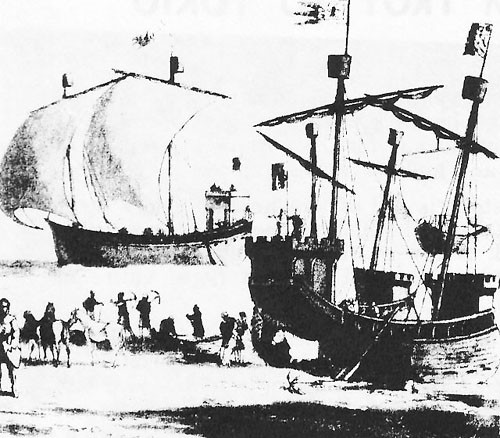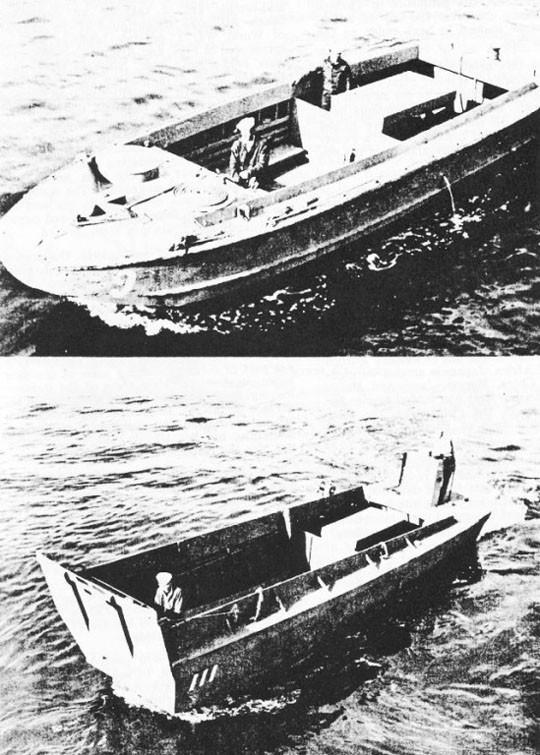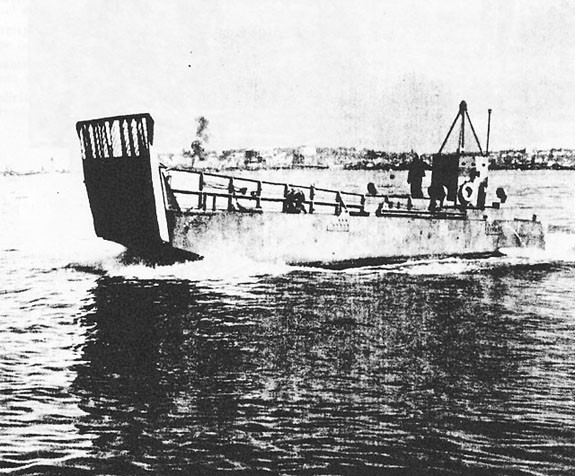
The Navy Department Library
Chapter II. Landing Craft From Troy to Tokio
Historic sea-borne invasions.The amphibious operation is not new. Long before World War II, ships and men were crossing unfriendly waters to land in enemy shores. One of the first landing operations of which there is a record dates back to nearly 3,000 years ago! This was the half-legendary attack of the Greeks upon the city of Troy in Asia Minor near the Dardanelles.
A women is said to have been the cause of it all. Paris, the son of Priam, king of Troy, made off with Helen, the wife of the Greek king, Agamemnon. Agamemnon quickly assembled an amphibious force with the help of other Greek rules, and, in 1183 B.C., set sail.
The Iliad, an ancient poem said to have been composed by the blind poet, Homer, describes how the Greeks crossed the Aegean Sea and hit the beach near Troy. According to the story they drove ashore, beat off counter attacks on their ships and after ten years of war destroyed the ancient city. Helen was rescued and returned with her husband.
The powerful Persian ruler, Darius, launched a water-borne attack against the Greeks about 700 years later. In 490 B.C. Darius constructed an especially designed amphibious fleet for an attack on Athens. His shipbuilders developed a very remote ancestor to the LCM, a landing craft with a runway to let horses ashore. This "LCH" (landing craft, horse) failed to conquer the Greeks, however, and Darius made his landing only to be defeated. A second landing failed, likewise, and the Persians returned to Asia.
Yet another early action during the same century (414 B.C.) was the siege of Syracuse in Sicily by the Athenians. A large Greek fleet landed an army, but failed to take the city. Old records tell of "secret weapons" that were used: balls of flaming chemical materials hurled at ships from land-based catapults, and a huge burning mirror to gather and focus rays of the sun for the purpose of igniting the sails and hulls of wooden ships.
History is full of similar amphibious operations many of which succeeded, some of which failed. A few of these assaults from the sea shaped or changed the history of entire nations.
In 55 B.C. Julius Caesar landed two Roman legions on the Kentish coast in Britain, but withdrew them after a short while. A year later his men again leaped from their boats and waded through the surf, this time somewhere north of the River Thames, to defeat an early English king with the almost unpronounceable name of Cassioelaunus. By 50 A.D. The Romans had expanded this early beachhead until nearly all of Southern England was a province of their empire. Since they remained for nearly four centuries, the results of this amphibious operation were of lasting importance.
For 300 years following 789 A.D. an amphibious-minded people, the Vikings or Northmen wrote a lot of history with their shallow-draft dragon-ships. The Scandinavian homeland of the Vikings was neither large nor fertile, so one of their main sources of a livelihood came from the loot of amphibious raids against the British Isles and the European mainland. At one time or another the Northmen landed in Iceland, Scotland, Britain, Normandy, what is now France and Germany, Spain, the North African coast, Italy and Sicily. Eventually the Norse longboat, battleaxe, and horned helmet became known as far east as Constantinople.
One of the most historically important water borne invasions came in 1066 when William the Conqueror crossed the English Channel to Britain with what was a sizeable army for those
--4--
days. His boats were comparable in length to the smaller landing boats used today and were driven up onto the beach by rowers and a "coxswain" who directed the boat with a large steering oar. At Hastings, near the scene of his landing, William defeated Harold, the English king, and founded a new line of rulers. This was the last successful invasion of England.

The list of amphibious actions from 1066 to the present time is too long to give in detail in a manual such as this one. However, it is of interest to know of a few more of the main operations. In July of 1346 the English invaded Normandy almost 597 years before D-day in World War II. Then, also the invasion, led by Edward III, was a success. From a beachhead near Cherbourg the British advanced to Crecy where the English longbow men (the 14th century equivalent to tommy-gunners) blasted the armored French knights of King Phillip of Valois.
Between 1066 and 1940, when the Germans were accumulating barges for a channel crossing, England was only once in genuine danger of invasion from the seas. This was in the summer of 1588 when the Spanish Armada of warships and transports beat its way up the channel. Just what landing tactics the Spaniards had hoped to use was never learned, however, since the maneuverable English fleet smashed both the Spaniards' ships and their invasion hopes. A heavy gale which blew in at a fortunate time (for the English) completed the ruin of most of the Spanish fleet which escaped the English cannon fire.
In more modern times, large-scale landing operations were thought to be increasingly risky because of the perfection of small arms and heavy guns. Until the present war, when American ingenuity tackled the problem in earnest, amphibious operations frequently have been ill-fated or costly. For example, in 1775 the Spaniards sent 51 naval vessels and 344 transports to invade Morocco and smash the Moors. Early in July a landing was attempted in the Bay of Algiers.
Some 100,000 Moorish soldiers were in waiting and as soon as the Spanish troops were within musket shot of the beach, the slaughter began. Lacking power boats, the Spaniards could land perhaps a dozen soldiers per trip (at least as many men were needed to row through the surf and retract, and their craft moved slowly). As a result the luckless Spaniards were cut down before, or as soon as, they came ashore. The battle for the beachhead was lost before the last wave was in from the transports, and the members of the landing parties who were able to do so, returned to their ships in great disorder.
Landings on defended enemy shores, it seemed, were a thing of the past. Napoleon could not invade England in the early 19th century although he made many plans, and during the Civil War the Northern forces made no important landings along the coast held by the Confederate states. The danger and probable loss of life seemed too great.
Even early in the present century the landing of American Marines at Samar in the Philippines served to emphasize the element of danger in hitting the beach. Company "C" of the Ninth Army Infantry had been massacred by the Moros on Samar and the Marines were landed to convince the Moros of the error of their ways. The Marine units' boats were towed ashore by steam launches and made a successful landing, but the Moros, equipped with powerful rifles, took a heavy toll. Losses were large enough to make the cost of sea borne attack seem prohibitively high.
The only major sea-to-land invasion of World War I seemed to offer more proof that such actions were unlikely to succeed. At Gallipoli, in 1915, the Allies planned to turn the flank of the Central Powers. The Turks were informed of their intentions, however, and were well entrenched on the Gallipoli Peninsula. British and French troops coming in were pounded unmercifully and failed to get the support of
--5--
heavy fire from ships of the fleet because submarines sank several battleships in the Aegean Sea. Early in 1916 the Allies called off the entire show and left the peninsula in Turkish hands. To many observers the day of waterborne invasions seemed to have ended on the Gallipoli beaches.
What has this brief sketch of amphibious warfare in times past shown? First of all, amphibious actions are almost as old as recorded history. Second, many seaborne landings have been successful in the past and have helped to shape the course of history. Third, a generation ago it seemed that invasion from the sea was on its way into the discard.
Because it seemed a thing of the past, it is understandable that the term "amphibious warfare" was unfamiliar to the public in 1940 or 1941. Soon, however, on foreign coasts and beaches around the world, this type of warfare was destined to come into its own.
Modern landing craft. World War II, by its very nature, has forced seaborne operations into an important position and has made the Amphibious Forces a vital part of the American Naval Establishment. By the middle of 1942 Germany (with trifling Italian aid) swept opposing military forces out of western Europe and much of Africa. Japanese armies were entrenched in China, Burma, Java, and Malay Peninsula. The Jap fleet had landed armies for the occupation of the Philippines, the East Indies, and hundreds of Pacific islands and atolls.
These Japanese-German conquests were huge in extent and they could be rewon, in many instances, only by waterborne assaults. The Allies were left with no choice but to turn to what Admiral Hart has called "this most difficult and least known variety of warfare"--amphibious.
Fortunately, the American Navy was never convinced that amphibious warfare was dead. Perhaps this was due to the fact that in practically every military action in which it was engaged, the Navy has landed Marines on enemy shores. At any rate, when it became obvious that many World War II campaigns would begin with seaborne invasions, the Navy had plans to make landings successfully and practical experience upon which to draw. How well the development of "amphib" has progressed is indicated by the fact that radio networks and the press had announced more than thirty such landings by the third anniversary of Pearl Harbor.
In recent Naval history, special training for landings goes back to 1902 when Marine detachments were first instructed in the rough-and-tumble art of tackling an enemy-held beach. Although discontinued at the outbreak of World War I, practice landings were reintroduced in 1924, and Army-Navy maneuvers were held a year later. Nineteen thirty-three saw the birth of a landing force, the Fleet Marines, an outfit especially designed for landing operations. Also, by 1939, the Army was beginning to work on an amphibious program with its 3rd Division. By the spring of 1940 these troops and their officers had had invaluable experience in operating jointly with the Navy. Early 1941 saw the first Army-Navy-Marine amphibious maneuvers. The nucleus of the force that was to operate in the surf and on the beaches of three continents, and numerous islands and atolls, had been created.
When war came at last in 1941, the groundwork had been laid for the toughest, hardest hitting amphibious force ever organized. There were not enough boats or trained men in those days--not by a long shot--but men were on the way in a hundred camps and the boats and ships were on the ways in dozens of yards.
The men who operate the LCVP and LCM are part of a force manning some of the most ingenious (and certainly some of the queerest looking) large and small craft ever seen on the surface of the sea. In general appearance they are as unlovely as a collection of prehistoric dinosaurs, but beautifully efficient, nevertheless, for the respective tasks assigned them.
The early "ancestors" of the landing boats with which the following chapters are concerned, had been designed and were undergoing tests before the end of 1936. The Navy's Bureau of Ships, even at that time, had a clear cut idea of the hardy type of boat that was needed. It had to be fast and seaworthy, capable of carrying a sizeable load, and sturdy enough to run ashore on, and retract from rough and treacherous beaches. When the construction of the LCVP and LCM is discussed in a later section, some of the clever designing that was done will be evident.
The landing boats now used have changed in a good many ways. In some respects they resemble their 1936 ancestors no more closely than the smoothly running, functionally designed automobile that rolled off the assembly line in early 1942 resembles the angular, high bodied car of the late 'twenties. For example, the forerunner of the LCVP was built so that the coxswain stood in an exposed position near
--6--

--7--
the stern--an excellent target for small-arms. Even the experienced coxswain often wished for an extra pair of hands to help him handle the three separate control levers for forward and reverse gear and throttle, and, lacking the modern ramp, men landing on the back [beach] were obliged to vault over the gunwales and splash ashore with their equipment. Each of these faults in design has been improved. It must be admitted, however, that no one has ever been ingenious enough to make either the "VP" or the "M(3)" a thing of beauty. They remain awkward looking, stubby; the Ugly Ducklings of the fleet. But they have shown their ability many times, and when the blue chips are down, performance is the quality that counts.
This highly streamlined history of "Landing Craft from Troy to Tokio" is the one chapter of this landing boat handbook which cannot be finished at present. The events that will make some exceedingly interesting concluding paragraphs have not happened. The LCVP's and LCM's have not yet helped to supply the narrative for the part of the story that deals with Tokio.
As boat crew members, the men for whom these pages are printed will help write the ending. Careful study of the text which follows is one way in which each man can help to speed the story to a successful close. Learn your boat, master your job, get the hang of the important seamanship skills--and you can complete the chapter in record time.
So let's get on with "Know Your Boat!"

--8--
[End of Chapter 2]



